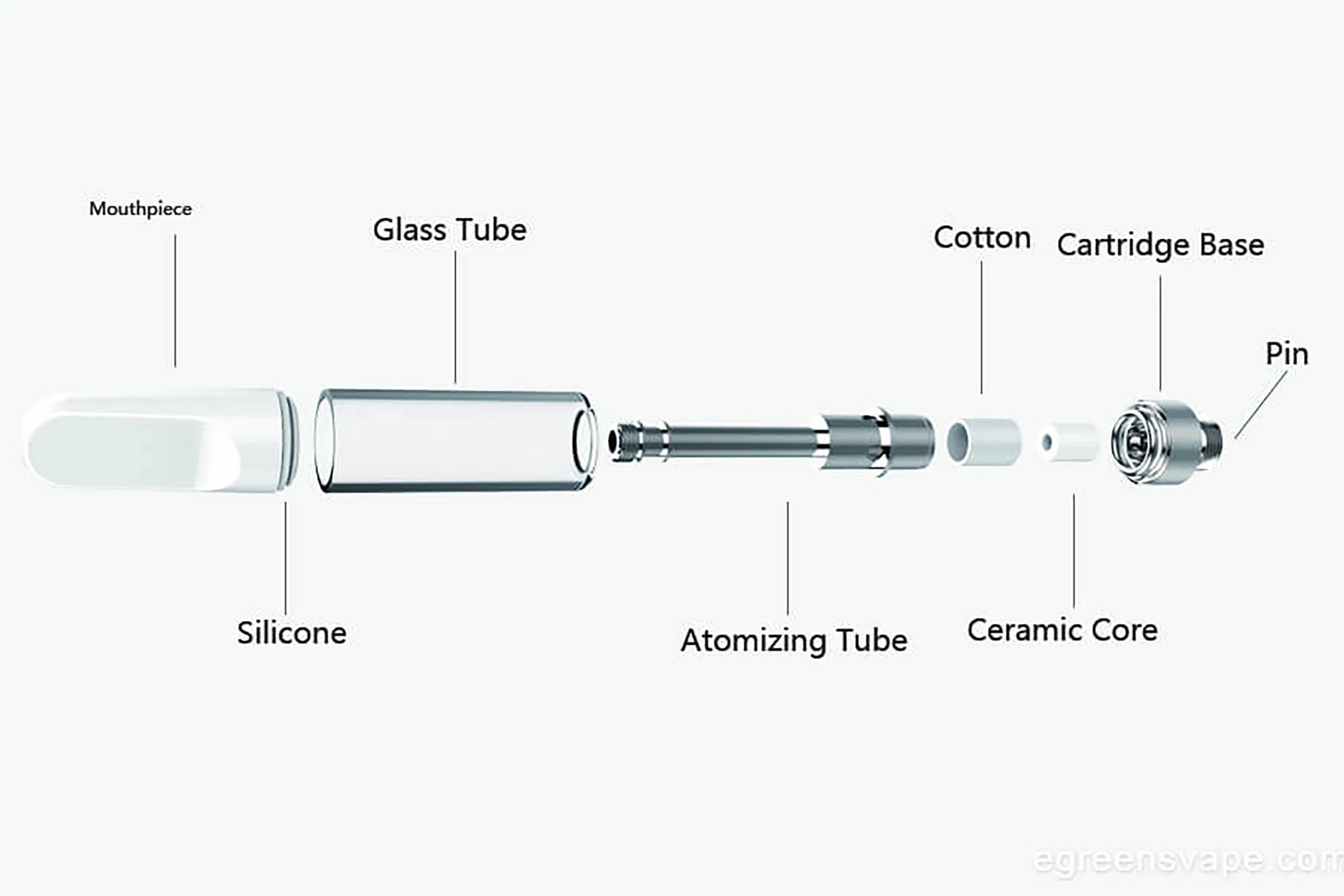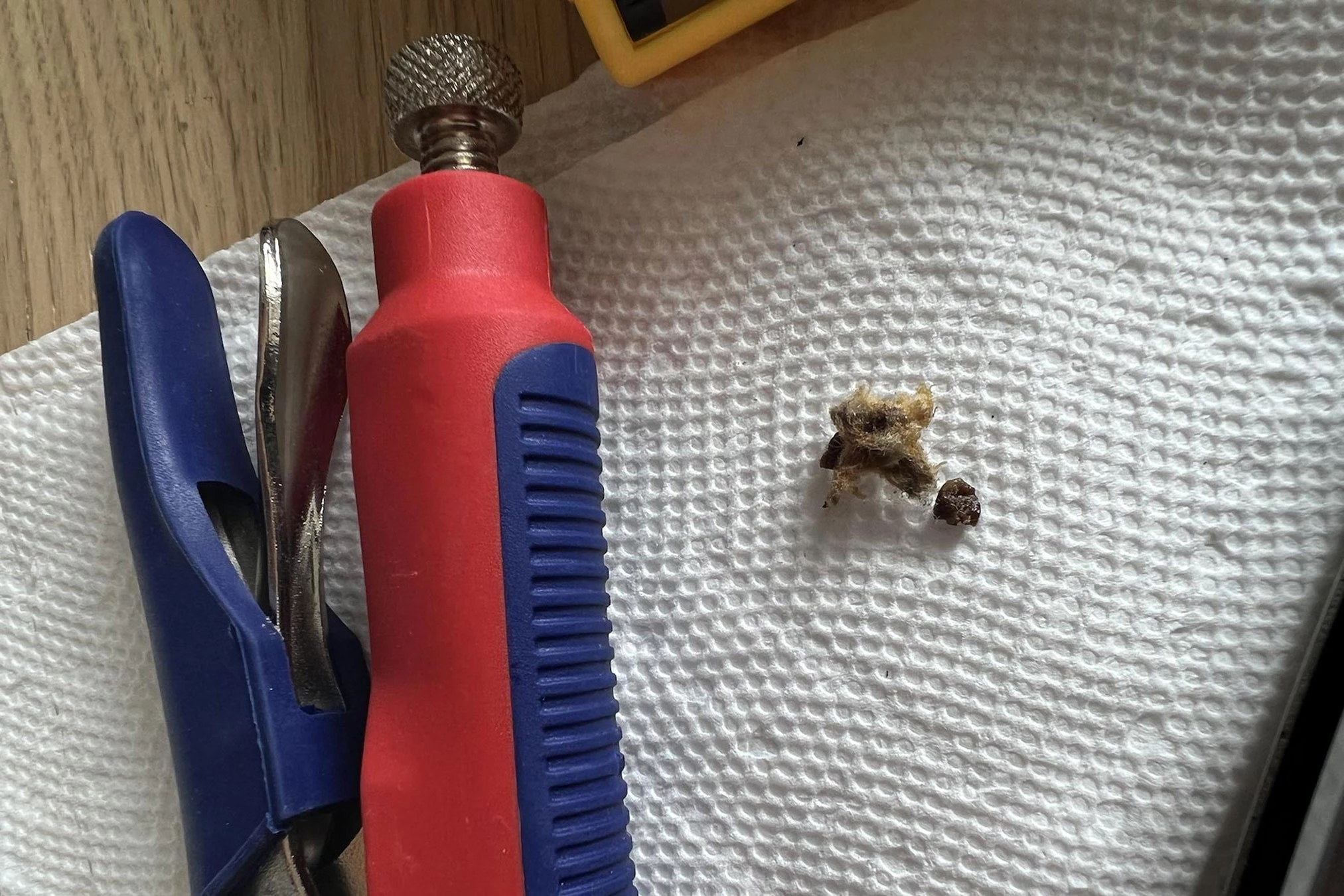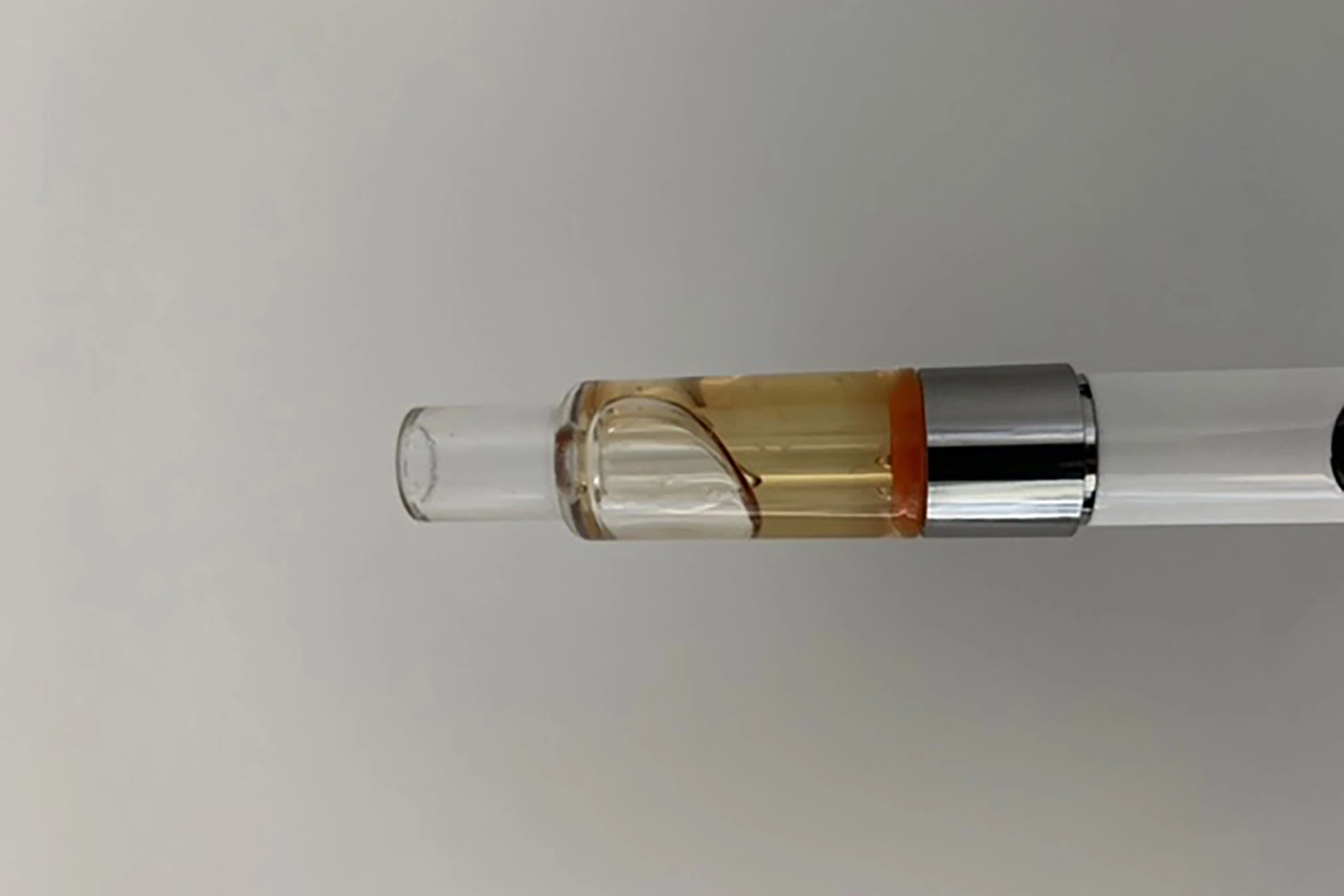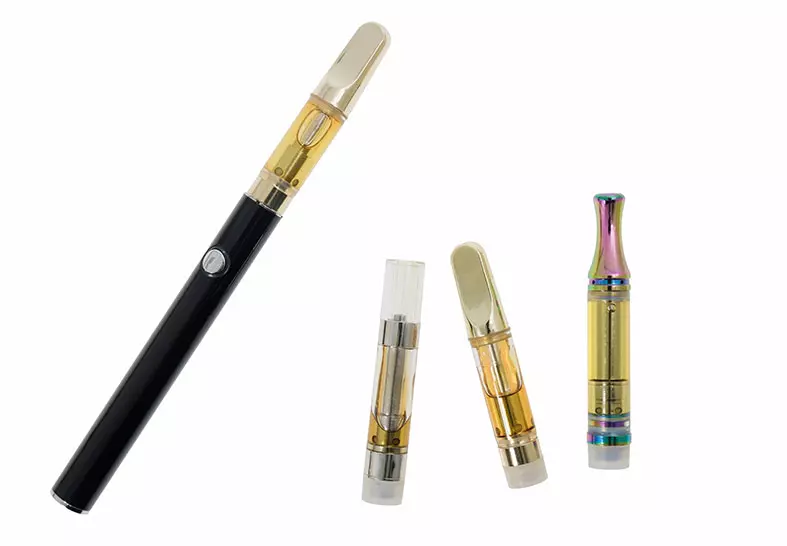The extracts segment of the cannabis industry has grown at a staggering rate over the last three or four years, and vape cartridges are a crucial driver. Consumers can enjoy the benefits of discreet, potent plug-and-play oils that give them predictable dosing on the go. There’s no serious learning curve to get the dosing correct, and you can feel the difference between a single dose and a few concurrent doses. Flavored carts make the experience more palatable than smoking, especially for new consumers. Plus, carts allow you to come back from a smoke break without smelling skunky.
Cartridges are efficient products. The hardware design is relatively standardized. Carts can be filled at the rate of thousands per hour. The oils can be extracted from flower that isn’t suitable to sell as smokeable. To be clear, a lot of un-smokeable flower gets used for products like edibles and topicals, just as imperfect fruits and vegetables are used for sauces, pastes, and jams. Even flower of completely garbage quality can be purged of harmful additives through the extraction process and used in carts.
Cart producers make substantial profits from this class of products. The hardware costs roughly a dollar on average per unit wholesale for the standard C-Cell style wick design; distillate extract is roughly $1 per gram or mL on average (premium extract costs a bit more), and automation keeps the labor cost of each cart to less than $1, regardless of the type of extract. Distillate carts can often be found at $30 for a full gram unit in markets with legal adult-use sales, like California, Michigan, and Maine, which amounts to a roughly 10x markup. Traditional market operators commonly buy carts in bulk amounts of 50 or more and double their money.
While carts bring in huge revenue and can be a great way for new customers to experience cannabis, they also have flaws, some of which begin before the hardware is even filled. Some of the most researched health risks may occur after the product is released. While legitimate hardware and extraction innovations have come to the forefront over the last couple of years, it’s disputed whether they’ll be enough to combat the damage these products may have already done to users’ bodies and the industry at large.
How THC vape cartridges are made
THC vape cartridges are made up of three main parts: a mouthpiece, a heating element, and an oil chamber. The most important of these parts is the heating element or atomizer, which is commonly made from a ceramic element that gets heated with a kanthal or stainless steel wire connected to a power source. The powered ceramic heating element is usually wrapped with a piece of cotton or other fiber to wick the extract for vaporization. Most carts have a metal center post that directs the vapor and extrudes out near the bottom of the device, providing a housing for the heating components with exposure that allow the cotton to wick.

The heater and center post housing is normally connected or welded to the bottom of the device where the 510 thread connector (10 threads, 5mm apart) sits. The filling chamber is made by fitting a hollow glass or polycarbonate tube around the bottom of the heater and sealing it with silicone or viton o-rings.
The cart is filled with viscous extract either by hand or with a machine, and then the mouthpiece is screwed on. The mouthpiece is usually made from ceramic, stainless steel, a chromium-plated alloy, or polycarbonate. Some of the newest filling machines, such as Cool Jarz’ A-10 HotShot™ 1500, claim to be able to fill 12,000 carts per day (which means the almost $17,000 price tag is an easy business expense to justify).
Deficiencies with THC vape carts
While carts have become one of the most popular ways to smoke, especially amongst smokers and medical users trying to be discreet, carts haven’t proven themselves to be safe without a shadow of a doubt,. The problems start with the hardware: the standard C-Cell design we described above was repurposed from nicotine vaporizers. The design for what we would consider the genesis of e-liquid vaporizers was created by a Chinese pharmacist named Hon Lik. His design is called a cig-alike in the nicotine vaping sphere, and is still sold in convenience stores in products like the Vuse Solo, which is one of only a handful of products that have been approved for Pre-Market Tobacco Application (PMTA) with the FDA.
This cig-alike design was improved with the advent of the “clearomizer,” which traded in the closed non-refillable cartridges with a wick made from a wad of cotton in a clear housing with longer strings of wicking to uptake e-juice. The clearomizer was eventually updated with a replaceable atomizer, and subsequently an integrated atomizer and center post that we see in most vape carts today.
The predominant issue with these pieces of hardware, despite having evolved from their inception in 2003 to standardization around 2016, is that none had cannabis oils and resins in mind for the wick design. Cannabis vape users find this disparity apparent with center posts clogging and leaking. In nicotine vapes, excess vapor that condenses falls from the tip back to the filling chamber. But because cannabis extracts are stickier, the vapor condenses to an oily, waxy consistency that gets caught in the center post. Some cart designs (namely the TIK Pro and the Nord models of pods from iKrusher) have added cotton pads in the mouthpiece to capture excess vapor, which prevents clogging, but still doesn’t deliver all the vapor to the user as intended.
While vape juices are made primarily from vegetable glycerin, propylene glycol, flavor compounds and nicotine (either liquid or salt-based), cannabis oils for vaping are made with either crude distillate, supercritical CO2 extract oil, high terp fraction refined resin (HTE), or hash rosin, as well as botanical or cannabis-derived terpenes. E-liquids are generally more viscous and are easier to wick, whereas cannabis concoctions are more crude, which means the wicks have a harder time absorbing the mixtures and the device requires more heat to vaporize them. This can break down elements of the device after a lifetime of overheating.
When heated to 410o F, cotton can smolder or burn, and burnt cotton can leave cotton oil residues if scorched to ash. According to New York State’s Integrated Pest Management program through Cornell University, cotton oil’s acute 90-day repeated-dosing effects on humans for inhalation have not been determined, but the report found that acute, prolonged oral ingestion proved to be mildly toxic. With cannabis vapes, this is an issue because we can’t expect labs to test for cotton oil residues, and we don’t know the extent of toxicity of long-term residue build-up in chronic vape cart users. There’s also the reality that a smoldered wick negatively affects flavor and overall smoking smoothness from vape carts, and such a high rate of device failure due to being highly prone to user error would generally be considered unacceptable from other medicinal products or consumer commodities.

The different types of carts, including distillate, CO2, HTE, and solventless carts also require varying amounts of power to heat each type of extract to its optimal temperature, but they’re not filled into different types of hardware based on wicking ease. Distillate carts sell at much higher volumes than other types of carts, and require the highest voltage to operate. Even though many cart labels give directions on how long to draw on the device, users frequently must tinker with their dosage to achieve the optimal puff. Even though the intended use for these devices is a 2-5 second draw at no more than 2 draws before the device must be rested so as to not overheat, not every consumer uses the devices in this way or knows this technique.
In a small-sample teardown of six different models of carts by our team as well as six other teardowns from Kung Fu Vapes on their social media, we found that all but two of the carts had some sort of smoldering or burning on the ceramic heating element and the fiber wicking from normal to heavy use. In a few cases, the ceramic was burnt to a point where the material had become brittle, which could lead to the ceramic within a functional device shattering on impact after a normal low-height drop, leaving the user with a broken coil.
Most of the carts we tested used some variation of the C-Cell design philosophy described above, either in 510 cart form or proprietary pod form, with a couple using nano-porous ceramic heating elements. This burning appeared worse in carts that were drawn on for so long as to cause a blinking battery light, what many enthusiasts refer to as “blinkers,” which is a common practice for cart users who want to take especially potent plumes. We don’t believe it’s a jump in logic to assume that cotton smoldering and burning is a common device failure, and an especially insidious one for a closed product where users often don’t have the hardware knowledge to repair their products or diagnose such problems.
Scientific findings about health with vape cartridges
When carts are lab tested in states with legal adult-use cannabis sales, they’re typically only tested for arsenic, cadmium, mercury, and lead. In the case of California, an inhalable cannabis product fails cadmium and arsenic testing if more than .2 ppm is discovered in the mixture. The actionable level for mercury is .1 ppm and it’s .5ppm for lead. However, researchers at Medicine Creek Analytics think that this testing is not comprehensive enough.
According to “Metals in Cannabis Vaporizer Aerosols: Sources, Possible Mechanisms, and Exposure Profiles” published in Chemical Research in Toxicology, “Results indicate that chromium, copper, nickel, as well as smaller amounts of lead, manganese, and tin migrate into the cannabis oil and inhaled vapor phase, resulting in a possible acute intake of an amount of inhaled metals above the regulatory standard of multiple governmental bodies.” While the tests that Amber Wise, Ph. D, of Medicine Creek Analytics conducted used artificial apparatuses to record results rather than human testing, they found evidence of heavy metals leaching that they concluded was from the vape cartridge hardware rather than the resin. Similar results were not achieved through testing “non-cartridge heating methods of cannabis flower and concentrate” as a basis for comparison. It’s also important to note that this heavy metal leaching is more prevalent in carts made with metal center posts, specifically those made from alloys such as plated chromium rather than surgical grade stainless steel and ceramic. The risk seems to be directly correlated with how much metal the resin is in contact with in the hardware, which is why ceramics have been a popular option in newly developed hardware.
In an interview with Terpenes and Testing Magazine, Dr. Wise described three factors that achieved higher results of heavy metals in the vapor aerosol. The first is storage. Dr. Wise’s team filled extracts that had no traces of heavy metals into carts and stored them in a space that was slightly hotter than body temperature to emulate leaving a vape in a hot car. When the extract was removed and retested, the results showed heavy metals present in the extract.
The second factor lies in the type of extract the cart is filled with. Dr. Wise’s team found evidence of greater heavy metals leaching from carts filled with more crude oil than with more viscous oil that had terpenes in the mixture. “[T]he thicker oil creates air pockets where the heating coil can super-heat or oxidize and give off metal particles or gas,” said Dr. Wise.
The third factor lies in how frequently the vape carts are hit. While most vape carts are rated for around 50 draws per day, the hardware is designed to be used in moderation at the lowest possible voltage setting, and users should not be taking more than three draws per hour on average, which may not be enough to satisfy their requirements.
The final takeaway from Dr. Wise and her staff’s work is a call for post-production testing nationwide. In most states that sell cannabis vapes, only the filling material is required to be tested, which means that carts frequently aren’t tested as a packaged product. Luckily, vape extracts released for California’s adult-use retail market must pass testing after being filled in hardware. We think this testing should go one step further, in which an avenue for accessible post-purchase testing should be available to determine whether the carts have leached heavy metals while in storage before purchase. Dr. Wise assures in the interview that the potential danger for these amounts of heavy metals doesn’t necessarily outweigh the medical benefits of using vape carts, but no results have been published about long-term heavy metals exposure from vaping.
The 2019 findings of lung injury from cutting agents such as vitamin E acetate found in traditional market carts is also concerning. A VICE report in Oct. 2020 found that many of the carts found on the traditional market were counterfeit, using knockoff hardware of questionable materials and potentially filled with cutting agents. It’s unclear currently how dangerous these counterfeit designs are and how much worse they are for heavy metal leakage, as well as how the cutting agents interact with hardware materials, but in the video, a counterfeit Big Chief cart was tested and found to be 8.5% vitamin E acetate which Dr. Christopher Hudalla, founder of Proverde Laboratories, states is “potentially deadly.”
Hardware innovations in vape cart technology
Over the last three or four years, a few companies have made strides in vape cart technology specifically for cannabis use. One example of this is QBD’s G-Cell, an all-glass body and center post design with an all-ceramic heating element. The response from the Future 4200 community from testing was largely positive, with very few reporting the glass body breaking from impact. The consensus about the design is that it clogs much more readily than the standard C-Cell style, but the flavor is comparable to dabbing.

We mentioned Kung Fu Vapes, which in addition to tearing down popular vape carts has produced two of their own lines of cannabis vaping devices. One is called the Quasar Pod, which is similar to a Stiiizy with a reusable battery and disposable pods. The other is their Sirius pods, a top-filling full disposable unit. Both use a heating element which CEO John Dawson refers to as a “horizontal ceramic bucket” or HCB, which is similar in dimensions and function to CCell’s FEELM nano-porous ceramic heating element found in the NJOY Ace e-cigarette, another one of the few models recently approved for PMTA. These work by holding extract in the pores of the heating element, allowing it to be vaporized as the ceramic heats.
We tested the original iridescent release of the Sirius pods and found that the device was easy to self-load, worked after many fillings as claimed by the KFV team, and draws were quite flavorful and full compared to many other vape carts we’ve tried. We were also able to hit extracts to blinker repeatedly without worry of the cart overheating or smoldering a cotton wick. The vapor heat was a little bit high, but they have a low-temp model that they’ve released since our initial testing. The material design left a bit to be desired, identifying more polycarbonate components than we’d like for a product that costs almost $4/unit at wholesale with a minimum order quantity of 5000 units, but overall we found the design has fewer points of failure, such as heat-resistant viton grommets, than the standard CCell style design. Dawson and his team have been iterating on this HCB design for a while now, as the original Quasar design with an older model of the ceramic heating element was released over three years ago, so we suspect that the design and the engineering will only get better over time.
Additionally, we spoke with Davis Clayton Kiyo, creator of the Octave brand that is responsible for the Clean Core cart system. Many of the I-71 vendors in DC carry Hive brand carts, which are Clean Core carts filled with HTE extract. Octave’s major innovation in the space was creating a completely closed filing system for carts. “We think the closed system is the future for carts because it’s the logical progression we’ve seen in other industries,” Clayton Kiyo said, “and we’re pretty sure it’s going to be the next standard in this segment as soon as the FDA looks into [cart production processes] because the open systems are not hygienic." Clayton Kiyo said that for systems where carts are filled in an open device, contaminants such as dust can find their way into carts even in the most sterile environments. He also said that open filling leads to greater oxidation, which is what happens when a user notices non-uniform resin coloring later in the product’s lifecycle.
For consumers, the most impressive part of the Clean Core system is the unibody cart design made from a ceramic that's high-quality enough that Octave claims it’s considered porcelain. After many iterations of design, including some made with stainless steel center posts, Octave determined the unibody porcelain design was the highest quality due to having a lower than .02% product defect rate, which Clayton Kiyo said is getting lower the more carts they produce and is the key to making a product ready for the demand of national legalization. In our testing of Clean Core carts, we found that the hardware construction was superb and the flavor from the HTE in the Hive carts was like dabbing extracts off a quartz banger, despite the coil being of the older fiber wick design. We were also given a prototype of the improved Clean Core design that has a longer mouthpiece and more wicking intakes, and although we were not able to fill and test the unit, it’s an apparent improvement that exemplifies Clayton Kiyo’s constant drive to iterate and improve on Octave’s products.
For producers, the Clean Core filling machines are the much more impressive part of the equation. The machines can fill the unibody carts by inserting a small, specialized needle through the top of the cart. This allows for carts to be filled without the resin ever touching the outside air and creates massive labor savings at scale because carts don’t have to be capped after filling. Clayton Kiyo believes that the cart segment alone is set to become a billion-dollar industry and claims that the whole Clean Core system is perfect for large scale producers such as MSO-owned brands that will require precise, hygienic and failure tolerant systems for cart filling, as well as an intuitive system for meeting regulatory compliance at such large scale.
With both Kung Fu Vapes and Clean Core, manufacturing takes place in China, as it does with almost all vape technology. Both producers say that the key to making excellent products that come from China is to be in the room where quality control happens. China is not a country of cannabis smokers, but according to Clayton Kiyo, the cultural drive for creating the highest quality goods is what many of us idealize American manufacturing to be. Clayton Kiyo developed his product design and manufacturing team in China while living there to oversee production, and he says the bond he forged with his team inside and outside the office is what built the trust and communication required to design high quality products through extensive iteration and prototyping.
In a video teardown of the newest version of the 710 Labs vape pods hardware on the Kung Fu Vapes Instagram page, John Dawson details the difference between the lighter colored white HCBs in the 710 Labs pods and the darker gray HCBs used in the Sirius pods by saying that the lighter ones are the most standard version of the hardware you can find in Chinese manufacturing catalogs, which seems like a legitimate claim considering the original version of the Quasar pods used that style of HCB before moving to the darker style for Quasar V2. Most vape product manufacturing happens in Shenzhen in the Guangdong region of China, which is considered a Tier 1 manufacturing city and is where manufacturing giants like Foxconn (who makes and assembles most parts for iPhones) are located. Dawson alludes to there being a vast difference in quality between products that are constructed from “catalog parts” and products that have had extensive iteration, prototyping and more hands-on quality control by cannabis enthusiasts.
The future of THC vape cartridges
Over the last few years, we’ve seen serious acceleration in vape cart innovation geared towards cannabis use, rather than innovating for e-juice use and adding modifications for cannabis extracts. Some of this has been on the hardware side, and some has been with resins, as producers figure out better methods for filing carts with higher quality resins than distillate, like strain specific HTE and live resin, as well as decarboxylated hash rosin. Carts have also never been easier for home brewers to produce. One example of this is GobShop, who set the I-71 cart segment ablaze with their home brew strain-specific live resin and shatter carts produced with techniques they learned on the Future 4200 forum, some of which they've shared on the I-71 Discord server.
Cart manufacturers like Kung Fu Vapes, AVD and QBD offer sample packs of 1-100 units for producers to fill and test before making a massive wholesale order, and some savvy cart producers have figured out how to find the hardware they’re looking for directly from Chinese manufacturers rather than purchasing through American distributors. Most HTE and strain specific live resin carts are made by using hydrocarbon extracts as starting materials, mechanically separating the THCA from the other waxes, terpenes and metabolites, decarbing the THCA in a vacuum chamber or with heat to convert the THCA into activated THC, and then mechanically forcing the THC and other materials back together so the mixture ready for filling. A contingent of especially skilled producers have figured out how to scale down this process to make batches of 300 or fewer carts, rather than producing batches of tens of thousands of carts, which makes the whole process much more accessible to home brew brands.
Additionally, the material design has been steadily improving over time. When we asked Davis Clayton Kiyo about why they chose the older type of coil and wick heating element design, he told us that the design choice came from testing a variety of styles of heating elements, and the one they ended up with met their standards of failure tolerance and vapor flavor. Clayton Kiyo also expressed the opinion that these full-ceramic heating elements are a design fad and assured that there are more advanced designs with higher quality materials coming down the pipeline, which he opted not to tell us about in detail.
While the cart segment has innovated rapidly over the last few years, it still has a long way to go. Some of the most expensive carts marketed as premium devices are still using designs repurposed from nicotine vapes, they’re using potentially unsafe materials to construct them and they are still using resin concoctions that reflect the producers’ desire to get the most out of product that's of garbage quality. The success of the segment has depended on consumers fending off the products without asking questions, which means it’s on the producers to make safer products that are easier to test to avoid large scale product recalls or health issues. While we think carts are one of the driving forces in discreet cannabis use and social acceptance, those things mean nothing if the product is hurting users. Even though the last few years have seen innovations in hardware, producers still have a marathon to run and a whole industry to disrupt.
